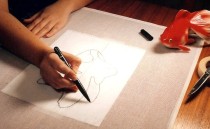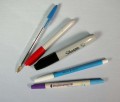Transferring Designs to Canvas
Marking or Tracing the Design
If you do not wish to paint, you can trace the patern directly on the canvas.
We have many options to use when transferring our motif on canvas. Some are very poor choices and others are great. Let’s take a look at them:
Pencils: In the 70's, we were told not to use pencil on fabrics and canvas. Smudges occur and the lead will make our fabrics deteriorate. Today, many people use them but, smudges can still occur. If you need to erase mistakes, use a white eraser or you may wish to use a gum eraser which you can find in artist supply stores.
Black Markers: These create thick lines and if you wish to use one, be sure it is permanent. Get the canvas wet and see if the ink will run before you use them. Many will bleed when wet.
Ball Point Pens: Never use ball point pens! These are a disaster waiting to happen.
Mark-B-Gone: is a blue marker which disappear when wet.
Two End Mark-B-Gone/Disappearing Ink pen: One end has the blue water soluble tip and the other has purple tip which will disappear in one or two days. (I have found, the purple will disappear much sooner but it does make nice lines for short term markings.
How to Transfer
- Place your drawing on the table and secure with painter’s tape.
- Lay down the needlepoint canvas on top. Be sure the canvas is straight on the drawing. You do not want trees, buildings or other objects leaning in silly directions. You will see the drawing and canvas is the same size. You will want 2 extra inches of raw canvas on all four sides for blocking and finishing.
- Secure the canvas on the table with tape.
- You are ready to transfer.
- It is best to draw fine lines on the canvas. This will give you exact placement of color and stitches.
- When you are finished, the canvas is ready to be mounted on stretcher bars or stitched in the hand.
Please remember: always test your marker before using! Even if you are not planning on blocking your work when you are finished, at some point, the project may need to be cleaned. You don’t want disasters in your future.
Also, cover any marks with your thread when you are stitching. Always draw the thinnest line you can create on your canvas. This helps in the stitching process.








